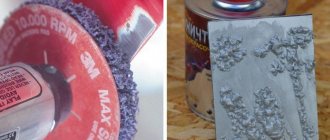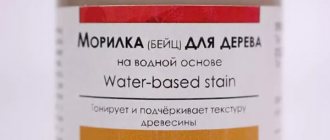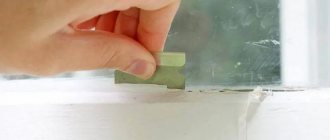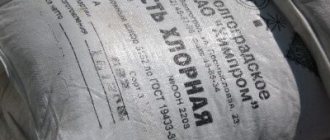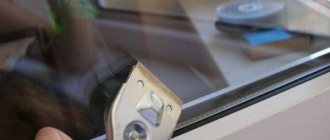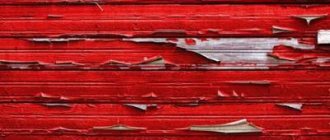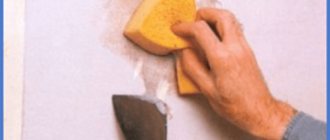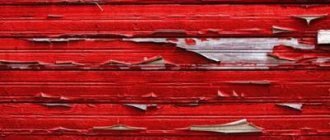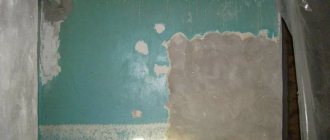Removing paint from a wooden surface without damaging it is not an easy task, but you can cope with it if you know some of the features of the work.
There are several methods to achieve your goal. Paint is removed mechanically, thermally and chemically, each of which has its own advantages and disadvantages.
You can learn how to remove old paint from wood at home from this article.
The need to remove old coating
How long the new coating will last depends on how well the old coating is removed. In some cases, it is possible not to remove the paint and varnish composition, but to apply a new top layer.
Mandatory wood surface treatment is required in the following situations:
- Irregularities. Occur if many layers have been applied to the product over time without removing the old paint;
- Defects in the form of cracks and chips. A new layer on such a base will not be able to lie smoothly and beautifully;
- Traces of wood cracking or swelling;
- The old layer has a warped texture or tight color that will stand out under the new, lighter tone.
Mandatory treatment of the wood surface is required for defects in the form of cracks and chips.
Preliminary preparation and tools for work
Wood can serve for several decades as a building material only if it is provided with proper ongoing care. When wood is exposed from old paint, it must be treated with protective agents. Otherwise, the new coat of paint applied will not last long.
READ ALSO: Korfad doors
Before applying the painting material, it is important to consider:
- age of wood;
- wood species;
- the thickness of the previous paint layer (single-layer coating does not always need to be removed);
- the shade of the old paint and its texture;
- service life of the previous layer of paint.
How to choose high-quality and durable LED light bulbs for your home? We have the answer!
Read about the advisability of purchasing an anti-vibration mat for your washing machine at this address.
You need to prepare the tools for work in advance:
- putty knife;
- construction hair dryer;
- Bulgarian;
- Grinder;
- chemical-based remover;
- rags;
- protective equipment (gloves, goggles, respirator).
How to properly prepare for upcoming work
Removing paint from wood requires using various tools and materials. It is recommended to prepare them in advance. You may need a spatula. Instead, it is permissible to use a wire brush. For the thermal method, a hair dryer is required. The temperature of the device must be regulated. The list of useful tools also includes:
- Hammer. A drill will also work, the main thing is that there is a set of different attachments;
- Grinding machine or circular saw;
- A special liquid composition designed to remove paint from wood;
- Rags. The product is treated with it to remove the remaining paint and varnish composition;
- Skin and respiratory protection products. Gloves and a respirator will do. You can also use a respirator.
Removing paint from wood requires using various tools and materials.
How to remove old paint
In addition to the products described above, special chemical removers are often used, which contain formic acid, dimethyl chloride, and other organic substances. Such reagents differ in the rate of decomposition process, and therefore they can be considered almost harmless.
Chemical wash works well with water-based paint - if the product is covered with one or two layers, it will be easy to wash off with store-bought reagents. There are several ways to remove paint coating using products that you can even make yourself. The water-based emulsion can be easily and simply removed using wallpaper glue or paste. The entire surface of the product should be coated with adhesive and newspaper should be glued. After drying, remove the paper with a spatula, and along with it, the layer of paint will come off the wood.
Using mechanical methods of removing paint, you can do everything quickly, and you should give preference to a drill with a special attachment, which can be used as a brush with metal bristles, which does an excellent job of processing a multi-layer water-based coating, because it cannot be removed with a spatula. The only drawback of this method will be a lot of dust formation in the apartment, which means that when carrying out such work in the kitchen, you need to cover all the furniture with film.
Mechanical restoration
When figuring out how to remove old paint from wooden surfaces, they often choose the simplest method. It comes down to mechanical removal of the paint layer. There are several ways to do this. First you should evaluate the structure of the material. If the wood is soft, then abrasive particles from tools will destroy the product.
When using any mechanical method, do not press hard on the tool. This will ruin the surface. Movements should be smooth.
When using any mechanical method, do not press hard on the tool.
Processing the product with sandpaper
Sandpaper allows you to quickly erase the old coating. But suitable for a thin layer. Repeated staining of sandpaper will not completely remove it. Also not suitable for difficult places on the product.
The technology for using sandpaper consists of the following steps:
- Prepare the sandpaper. You will need several sheets of different grain sizes.
- Begin by processing with coarse sandpaper. This will remove the top layer.
- Change the coarse grain to a finer one and use this sandpaper to clean the wood. The treatment is carried out until the surface becomes smooth.
To make the process easier, it is recommended to take a piece of timber and wrap it with sandpaper. It’s more convenient to work this way. The advantage of this method is the low probability of damage to the product and the availability of tools.
To make the process easier, it is recommended to take a piece of timber and wrap it with sandpaper.
Cleaning the product with an angle grinder (angle grinder)
The grinder cannot be turned on at full power when used in this case. It can damage the wood. To quickly get rid of the old paint layer, it is recommended to use a petal nozzle. The workflow is simple. You need to take a stable position, grasp the tool with both hands so that it does not slip out, and begin to process the surface. Paint particles quickly clog the discs of the machine. Therefore it is necessary to change them regularly. When the last layer of paint appears, it must be removed manually. To do this, use sandpaper. The resulting dust can be wiped off with a cloth previously moistened with water.
The grinder cannot be turned on at full power when used in this case.
Using a drill
The drill must be kept perpendicular to the wood when processing. The movements are not abrupt, smooth and accurate. Efforts need to be applied slowly and gradually. Paint particles may fly in different directions. Therefore, when choosing this method, be sure to use safety glasses. To avoid damaging the product, it is recommended to use special grinding attachments.
The drill must be kept perpendicular to the wood when processing.
Hard paint brushes
When using a hard brush, the product being treated must be taken outside. If this is not possible, all surrounding objects and surfaces are wrapped and covered with polyethylene.
This method consists of the following steps:
- An ax is used to make notches on the product. The wood is moistened with water and left for a couple of minutes so that the liquid is absorbed.
- The surface is treated with a metal brush, removing the top painted layer. To increase the effect of the process, it is recommended to hold the tool at an angle to the product.
- The bottom paint layer is removed with sandpaper.
This method is often used to process doors and window frames.
When using a hard brush, the product being treated must be taken outside.
When should paint be removed?
Conventional paint as a finishing material is familiar to everyone; it is perhaps the most popular type of finishing used to give a finished look to floors and other surfaces of any type. It not only allows you to decorate the walls or base of the apartment, but also protects the surface of the floorboards from excess moisture, exposure to sunlight, various parasites, etc.
Wood floor paint
But, like any other coating, the applied paint periodically needs to be updated. For example, when there is a renovation that does not involve removing the old floor covering, there is a need to repaint the floors or simply change the color of the floor so that it matches the design and interior of the room, the paint must be removed.
Also, removing paint from wooden floorboards is carried out in the following cases:
- deterioration of the general appearance of the floor;
- peeling paint;
- changes in coating color;
- stain formation;
- the need to level the floor;
- installation of tiles on a wooden base.
Wood floor repair
On a note! Many apartment owners, wanting to save time and money, apply a fresh coat of paint to the old one, but this is not recommended. One of the reasons is the formation of a layer that is too thick, which will prevent the doors from opening normally. Also, the new layer may lie unsightly, which will ruin the entire appearance of the floor.
It is not recommended to apply new paint over old paint
The most problematic thing is to remove the old paint that was used to paint the floors back in Soviet times. This is due to the fact that over the entire long period of operation of the floors, the pigment of the paint and varnish material has managed to penetrate deeply into the structure of the wooden base, which is why it will not be easy to remove such a layer of coating. But if you want, you can handle any paint layer.
You can remove any paint if you wish.
Thermal method for removing paint from wood
The method is considered universal. Heat treatment allows you to get rid of even old or cracked paint. If you need to process a large-sized product or with hard-to-reach places, you should choose this method.
To carry out the work, one of the following tools can be used:
- Gas-burner. The work is done outside. Can be used for the façade of a building, window frames and entrance doors. It is assumed that open fire will be used, which requires compliance with safety precautions. The burner is turned on and the surface begins to be processed until bubbles or streaks appear. The melted paint is removed with a scraper;
It is assumed that open fire will be used, which requires compliance with safety precautions. - Construction hairdryer. Can be used indoors. All you have to do is turn on the hairdryer and direct a stream of air onto the wood. The painted layer will begin to melt and bubbles will appear. The resulting drips are removed with a scraper. To make the process easier, it is necessary to regularly clean the tools from traces of paint. To remove paint from difficult areas, use a wire brush. The hairdryer acts more gently and gently on the wood. It doesn't burn her like a torch.
To make the process easier, it is necessary to regularly clean the tools from traces of paint.
Before using any of these tools, it is necessary to prepare the wood by brushing it with a stiff brush. Then the dust that appears is removed and the main stage of work begins.
When the process is completed, the surface is treated with fine-grained sandpaper to get rid of minor defects. Additionally, the surface is degreased. Alcohol or solvent will do.
Why the coating may not wash off well
You need to immediately understand what kind of coloring agent this is and what it is made of. After this, you can answer the question of how to remove acrylic paint.
Acrylic paint is a polymer, water-dispersed composition, which includes copolymers as substances for forming a film. Polymers (translated from Greek) are substances consisting of many parts. In fact, these are very large molecules. Dispersed - formed from several bodies that do not enter into a chemical reaction with each other.
The essence of these explanations is as follows. Acrylic is a complex, environmentally friendly chemical compound. It is produced with the participation of a film former, which is responsible for the curing time of the product.
When painting, drops of paint may end up on the floor, clothing or furniture. Sometimes the brush touches surfaces that there was no need to paint. How to remove drops or flaws in the work depends only on the time that has passed since they hit the objects. The hardening time of the film former is 30-60 minutes.
Chemical method for removing paint from wood
In this case, special removers or softeners are used. There are different compositions, which need to be selected based on the type of paint. Then the mixture will not damage the surface of the product.
Before using the selected composition, be sure to open doors and windows, ensuring sufficient ventilation in the room. All surfaces and products are covered with polyethylene so as not to get dirty. The softener or remover is poured into a separate container. The composition is applied to the surface with a roller or brush, depending on the consistency of the mixture. Leave the wash on for a while. On average, 20-30 minutes are enough for the paint to dissolve. Using a scraper, remove the remaining paint composition. In difficult situations, the remover can be reapplied.
To get the maximum effect from the procedure, you should choose the softener wisely:
- The gel consistency allows you to get the desired result faster than liquid, but this product is more expensive;
- If there is poor ventilation in the room where the work is being carried out, then choose products with a less aggressive composition;
- Cheap domestic solvents are not suitable for several layers of oil paint. They will not be able to cope with it and are suitable for simpler work.
Some washes cause darkening of the surface, which must be taken into account before starting work. In addition to the wash, you can use caustic soda. It must be mixed with water and stirred to the consistency of sour cream. Add a little oatmeal, pre-chopped. The resulting composition is applied to the surface and left until the paint layer swells. Then everything is cleaned off with a spatula.
On average, 20-30 minutes are enough for the paint to dissolve.
Chemical cleaning
The method involves the use of various reagents, which are sold in any specialized store. To remove a thin layer of paint, ordinary acetone is sufficient. For thicker ones, it is powerless, and you should purchase a stronger solvent. If a person is not sure about the composition of the drug, then it makes sense to ask for advice from a store consultant.
If paint removal is carried out indoors, then all windows should be opened before treating the surface with chemicals.
Detailed instructions:
- It is necessary to cover all objects that may come into contact with the solvent.
- Pour the solution into a paint container.
- Soak the brush in the wash and gently squeeze out.
- Apply the reagent to the surface and wait about 30 minutes (the exact time should be indicated in the instructions for the solvent).
- Clean the product by scraping off the softened layer of paint.
The procedure is repeated until no traces of the dye remain. If it is impossible to ensure the supply of fresh air to the workroom, reagents with the least aggressive composition should be purchased. The method cannot be called the most effective, since solvents can remove paint from wood up to six months old.
Which option should you prefer?
To choose the most suitable method, it is necessary to take into account the characteristics of the product and the desired result. If high-quality and complete processing is required, several methods can be combined. They start with professional formulations, and the final cleaning is carried out manually. Handy tools like sandpaper help save money.
If high-quality and complete processing is required, several methods can be combined.
How to remove hardened acrylic from tiles?
Basic methods for removing liquid acrylic
- mechanical removal - you can use a knife, spatula, small screwdriver or sandpaper. ...
- warm water, if you need to remove frozen paint on the edge;
- chemical solvent - this product can be found in a hardware store or at a point with radio components.
Mar 20
2022 Interesting materials:
How to clean a black drape coat? How to clean cast iron cookware? How to clean a cast iron frying pan at home? How to clean a cast iron frying pan? How to clean the outside of a cast iron frying pan? How to clean a cast iron duck pot? How to clean metal money? How to clean the speaker on iPhone SE? How to clean a sofa without streaks? How to clean a sofa with home remedies?
Features for different types of dyes
When processing, it is also necessary to take into account the composition of the paint layer. The type of paint determines how effective the chosen method will be on it. For an oil base, a mechanical method with a grinder or spatula is suitable. It is recommended to remove water-based emulsion with solvents.
The acrylic layer is removed chemically or mechanically. Powder paint can be removed using a strong jet of water. It is recommended to wash several layers of any paint composition by heat treatment.
The acrylic layer is removed chemically or mechanically.
Features of polyacrylate-based paint
[blok_1_h2]
Using acrylic paint, the required color is given to various materials:
- plastic;
- tree;
- concrete;
- fabrics;
- brick;
- glass.
This multifunctional coating is used for exterior and interior finishing work. With their use, original suspended ceilings are obtained; acrylic is used for painting nails, covering small models and figurines. There are no restrictions when choosing paint color. The diversity of the palette will captivate every buyer. Its advantage over other types of paint can be considered the fact that acrylic does not flow after application to vertical surfaces. It fits perfectly, does not form unevenness or streaks.
A rich palette of acrylic paints is perfect for children's creativity.
Note: Acrylic is safe for people. It is used when painting children's rooms. A strong advantage is the ability of acrylic to allow air to pass through and resist moisture. Surfaces coated with acrylic paint are not susceptible to mold and fungi.
The differences from oil paint are the following:
- quick drying;
- no odor;
- no cracking.
Due to the advantages listed above, most users prefer acrylic paint for renovations in residential, office or industrial premises.
Acrylic has a significant feature, which is represented by its unique composition. The following components are included in acrylic paint:
- acrylic acid;
- water;
- dye;
- film former
Difficulties in washing stains are explained by the presence of a film that promotes accelerated hardening of this type of paint.
The most common mistakes
Many people make mistakes when processing a product that affect the efficiency and quality of the process. To prevent this from happening, you need to figure out what not to do during your work.
The most common mistakes include:
- Coating the entire area of the product with a chemical composition at once. First, you should apply the product to a small area;
- Using brushes that are too rough for cleaning. Hard abrasive particles will damage and destroy the wood;
- Leaving the composition on the surface for a long time. It is allowed to keep the mixture for a maximum of 2 hours, otherwise the structure of the product will be destroyed;
- Careless handling of tools during the thermal method. Overheating of the surface increases the fire hazard;
- Pouring the wash into a plastic container. The aggressive composition of the special product will damage the container.
Overheating the surface increases the fire hazard.
Universal cleaner
“Universal cleaner” is another special product produced by industry. You can buy it in stores that sell radio components. It is intended for cleaning and degreasing them, but at the same time it copes well with hardened acrylic paint, since it contains gasoline and alcohol. Apply the substance to the surface to be cleaned, and then wipe with a rag.
As you can see, nothing is impossible, and even hardened old paint can be washed off. Choose any of these methods, remember to be careful, and the result will not be long in coming.
Acrylic paint remover will easily remove old coating
Acrylic paint can be removed relatively easily if done within a few minutes after painting. But how often does it become necessary to get rid of paint immediately after application? Much more often the need for this appears when acrylic can no longer be removed with ordinary water. In this article, we will compare some methods for removing old acrylic paint from various surfaces.
Important Tips
When using the mechanical method, do not press hard on the wood so as not to damage it. It is recommended to use personal protective equipment, including gloves and a respirator. Protect surrounding objects and surfaces with polyethylene.
It is not recommended to heat the wall where wiring runs or electrical appliances are connected. After using any of the selected methods, the surface is treated with clean water.
It is not recommended to heat the wall where wiring runs or electrical appliances are connected.
Removing paint from wood can be difficult. But if you take into account the nature of the paint composition and the surface features, you will be able to choose a suitable and effective method. If necessary, you can repeat the removal procedure several times to achieve the most desired result.
Universal cleaners
A universal cleaner is a special product that is also used to clean acrylic paint from surfaces. You can buy it in stores that specialize in radio components. It is used for degreasing, but it can also remove acrylic, since it contains solvents such as gasoline and alcohol. The substance is applied to the surface to be cleaned, after which it is wiped with a clean rag.
So, we are convinced that acrylic paint can be removed from the surface quite simply. It is important to follow safety rules when working with chemicals, and the results of your efforts will not be long in coming.
Acrylic paint is water-soluble, so it is believed that it will not be difficult to wash it off. And indeed, within an hour after application, the coating is removed without problems. But how to wash acrylic paint if it has already hardened?
Special means
There are several special products that quickly and effectively get rid of paint. One of the most popular is wash. Simply apply it to a cloth and wipe the surface, and after ten minutes remove the residue with a dry cloth. For acrylic, both special and universal solutions are suitable. The main thing is to remember the safety precautions: use a respirator and rubber gloves, and clean only in well-ventilated areas. Similar precautions must be taken when simply carrying out repair work. But often many of us discover a paint stain when everything has already been put back in its place and we think that everything can be quickly cleaned without resorting to the use of protective measures.
Also, a universal cleaner is often used for this purpose. It contains alcohol and gasoline, so the product, originally intended for degreasing parts, will do an excellent job on acrylic coatings. But how to wash acrylic paint if there are no special products at hand?
In order to avoid unnecessary costs, you can use the following method. To do this, you need to stock up on the following tools and materials:
- warm water;
- any household degreaser (dishwashing liquid or soap will do);
- acetone, kerosene, gasoline or white spirit;
- sponge;
- cloth rag;
- brush;
- protective equipment (gloves, respirator, goggles).
The ideal option is fresh, not yet hardened paint. It is easily washed off with plain warm water with the addition of soap or dishwashing detergent. By the way, after painting, it is enough to leave the brushes in the same water for about twenty minutes and then rinse thoroughly.
But how can you clean stubborn acrylic paint? If no more than twenty-four hours have passed since the acrylic paint was applied, then you can get rid of it with a brush and a degreaser. Upon completion of the work, the surface must be treated with a sponge soaked in warm water.
The “heaviest” option is a well-dried coating layer. How to clean acrylic paint in this case? For this, more serious means are useful: acetone, gasoline, white spirit or kerosene. When working with them, be sure to use protective gloves. The substance must be applied with a sponge and left for about thirty minutes. During this time, the paint will have time to dissolve and can be removed with a cloth soaked in the same liquid.
To make acrylic paints, a film former is used, thanks to which it hardens in just sixty minutes. That is why you should take care to remove it as soon as possible and wash off any acrylic paint stains that appear immediately.
It is believed that water-dispersed paints are easy to wash off, and this is true, especially in the first few minutes after application. But in some cases, difficulties may arise, because each paint contains additives that give it special properties. Acrylic paints are widely used in our everyday life, and therefore it makes sense to talk about how to clean acrylic paint.
The composition of acrylic paints includes water, a coloring pigment, a small amount of acrylic acid and a film former, which ensures that the layer hardens within an hour after application. Therefore, the sooner you start the process of removing paint from the surface, the easier it will be. Let's take a closer look at methods for cleaning surfaces from acrylic paint.
Period from hour to day
60 minutes after application, the copolymers included in the product already have time to form a film. And removing an unwanted stain will require some effort.
To remove paint from plastic, metal and other surfaces, you will have to use the “services” of a degreaser. These include alcohol-based solutions, dishwashing gels, etc. Acrylic paints are easily washed off with their help if you apply the product several times, scrubbing the stain with a brush. Then the surface should be washed with warm water.
When working with fabric surfaces, you need to approach things with caution. Many solvents cannot be used in such situations. Therefore, you will have to stop at detergents.
Basic removal methods
Acrylic can be removed from any surface using several methods. Certain tools and means will be needed for this purpose.
- Undried paint can be easily removed with regular warm water; no chemicals are needed. When you need to clean your brushes after work, you can leave them in warm water for 30 minutes, then rinse.
- It will be more difficult to remove acrylic if the paint has been sitting for a while. After a few days, brushes and degreasers will come in handy.
- When a lot of time has passed and everything has hardened well, you will need to use a “heavy arsenal”. White spirit, gasoline, acetone, etc. will come in handy. Before work, you need to put on gloves. The painted surface should be cleaned of dust and dirt, and one of the products indicated above should be applied to it with a rag. After 30 minutes, the acrylic will begin to soften, and it will not be difficult to remove it with a cloth soaked in the solution.
Well, now let’s look at the cleaning technology in more detail.
